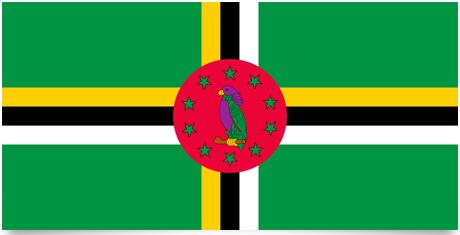Dominica Flag and Meaning
Flag of Dominica

Dominica Flag Meaning
The flag of Dominica was adopted on November 3, 1978. However, the color scheme was changed to the current 1981, from being yellow, white and black from the top. A yellow border was also placed on the stars. In 1988, the parrot got its current appearance.
The green color in the flag stands for the country’s rich vegetation, the cross stands for Christianity and the three stripes in the cross stand for the trinity. The yellow color of the cross represents the indigenous Caribbean population, the black color stands for the majority of the population coming from Africa and the white color is a symbol of the rivers and waterfalls. The red circle in the middle of the flag stands for socialism, the bird is the emperor Amazon which is a type of Amazon parrot and finally the ten stars around the parrot are for the ten congregations in Dominica.
Dominica Overview
| Population | 100000 |
| Currency | East Caribbean dollars |
| Area | 750 km² |
| Capital city | Roseau |
| Population density | 133.3 residents/km² |
| HDI location | 61 |
The largest of the islands in the Little Antilles in the Caribbean, located between Guadeloupe in the north and Martinique in the south. The island is of volcanic origin; its highest point is Mt. Diablotin at 2000m. The climate is tropical with heavy rainfall in the summer. Agriculture is concentrated on the production of bananas and cocoa.
The people: 89% of African origin; 7.2% European-African mastizer; 2.4% carriers,; 0.4% Europeans and others 0.7%.
Religion: The majority, ca. 77%, are Catholics; in addition, a number of evangelical sects.
Language: English is the official language, as well as a local French-African dialect.
Political parties: Dominica’s United Workers’ Party, DULP, led by Henry James. The Freedom Party, DFP, led by Maria Eugenia Charles; The Labor Party, DLP; The Democratic Labor Party, DEMLAB, which is a breakout party of the aforementioned, led by Oliver J. Seraphin; The Alliance of Dominica’s Freedom Movements, DLMA, founded in 1979, consisting of 4 organizations that opposed independence; Dominica’s Freedom Force, a breakout party by DLP, founded in 1983.
Official Name: Commonwealth of Dominica.
Administrative division: 10 municipalities
Capital: Roseau, 27,000 in (2003)
Other important cities: Portsmouth, 3,600 in; Marigot, 2,900 indb; Atkinson, 2,500 in; Mahaut, 2,400 residents (2000).
Government: Parliamentarism. Charles Savarin, President since October 2013. Roosevelt Skerrit, Prime Minister since January 2004. Re-elected in 2005, 09 and 14.
National Day: November 3, Independence, 1978 and the arrival of Cristoffer Columbus, 1493.













































